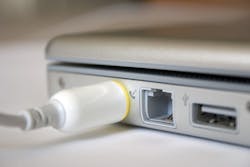IEC enables consumer-device smart charging to cut e-waste
Geneva, Switzerland. The amount of global e-waste—discarded electrical and electronic equipment—reached nearly 42 million tons in 2014. By next year it is predicted that the world will produce approximately 50 million metric tonnes of e-waste/year, according to a study conducted by a partnership of United Nations organizations, industry, governments, and scientists.
In an effort to increase consumer convenience and reduce e-waste, the IEC is now enabling a smart-charging solution that allows chargers to be re-used for many different consumer portable devices. The IEC has published new International Charging Interoperability Standards that open the way for a new generation of smart and eco-friendly charging solutions that can be used in every country in the world.
Chargers for products ranging from smartphones to high-power devices such as notebook computers will not only be compatible with the same types of devices from different manufacturers, they will also be able to charge a wide range of other kinds of electronics. Consumers will be able to use their notebook charger to charge a tablet or a smartphone or any other portable consumer electronic device. Likewise, if need be, a smartphone or tablet charger can be used to give a boost to a notebook, albeit at a slower rate.
This new smart charging approach relies on a standardized charging interface defined by the following new IEC International Standards:
- IEC 62680-1-3 and 62680-2, based on the latest USB Type-C and USB Power Delivery specifications, specify the common technologies needed to support charging of devices up to 100 W.
- IEC 63002, Identification and communication interoperability method for external power supplies used with portable computing devices, defines interoperability guidelines for chargers and devices that implement the latest USB technologies. In particular, it defines the data parameters for communicating power adapter characteristics and capabilities.
Global market adoption of these International Standards is expected to significantly increase charger re-usability well beyond smartphones and other low power devices, which were enabled by legacy USB technologies and related IEC International Standards IEC 62680-1-1, IEC 62680-2, and IEC 62684.
The standardization of this smart charging interface is supported by global industry as the best approach to enable broad reusability of different chargers with different products. It ensures charging reliability and provides the flexibility needed for future innovations.
Chargers can be designed to optimally match the power and functional requirements of the target product while being able to charge many other products as well. Devices will be able to communicate with the smart charger to accurately identify its capabilities before safely drawing power. The expected broad adoption by industry will exponentially increase interoperability, compatibility, and re-usability of chargers and as a result significantly increasing consumer convenience while contributing to global e-waste reduction.
Says Frans Vreeswijk, IEC General Secretary and CEO: “The IEC continues to be committed to reducing e-waste for developed and developing countries alike. These important new IEC International Interoperability Standards will further advance global environmental goals by substantially increasing the reusability of chargers for consumer electronics and ICT devices.”
Says Shin Eguchi, Technical Area Manager TC 100/TA 14: “This innovative charging solution is the result of unprecedented global cooperation and industry participation. Its broad adoption will truly benefit consumers world-wide.”
Says Jeff Ravencraft, USB-IF President and COO: “The continued cooperation between IEC and USB-IF on IEC 63002, that supports USB Type-C and USB Power Delivery specifications, aligns with USB-IF’s belief that consumer satisfaction, product functionality, and reducing e-waste are paramount. USB-IF is supportive of this significant step towards a new generation of interoperable, smart chargers.”
The IEC (International Electrotechnical Commission) brings together 170 countries, representing 99.1% of the world population and 99.2% of world electricity generation, and more than 20,000 experts who cooperate on the global, neutral, and independent IEC platform to ensure that products work everywhere safely with each other.
The IEC is the world’s leading organization that prepares and publishes globally relevant International Standards for the whole energy chain, including all electrical, electronic, and related technologies, devices and systems.
The IEC also supports all forms of conformity assessment and administers four Conformity Assessment Systems that certify that components, equipment, and systems used in homes, offices, healthcare facilities, public spaces, transportation, manufacturing, explosive environments, and energy generation conform to them.
IEC work covers a vast range of technologies: power generation (including all renewable energy sources), transmission, distribution, Smart Grid & Smart Cities, batteries, home appliances, office and medical equipment, all public and private transportation, semiconductors, fiber optics, nanotechnology, multimedia, information technology, and more. It also addresses safety, EMC, performance, and the environment.
About the Author

Rick Nelson
Contributing Editor
Rick is currently Contributing Technical Editor. He was Executive Editor for EE in 2011-2018. Previously he served on several publications, including EDN and Vision Systems Design, and has received awards for signed editorials from the American Society of Business Publication Editors. He began as a design engineer at General Electric and Litton Industries and earned a BSEE degree from Penn State.

